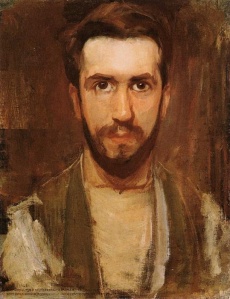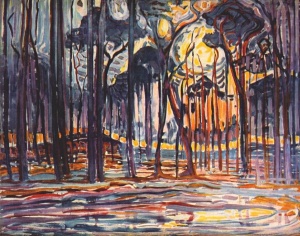Piet Mondrian
UNDER CONSTRUCTION
UNDER CONSTRUCTION
Pieter Cornelis "Piet" Mondrian (March 7, 1872 – February 1, 1944), was an influential Dutch painter, and one of the founders of the Dutch modern movement De Stijl. He also evolved a non-representational form that he termed neoplasticism, which consisted of white ground, upon which he painted a grid of vertical and horizontal black lines and the three primary colors.
Early life and education
Artistic career
Significant works
Woods Near Oele: This large canvas, whose subject has been identified by Mondrian's old friend, A. P. van den Briel, as the woods near the village of Oele in the Twente district of the eastern Netherlands, evidently marks a milestone in the painter's work. It shows the phase of his art in which his horizon opened up and he began to look beyond the somewhat narrow boundaries of the Dutch school. To be sure, it was Dutch artists who had opened up vistas toward more spacious regions for him. Among these artists in particular were Jan Toorop, then the representative of a "luminism" based on the experiments of the neo-impressionists, and Jan Sluijters, who, after returning from Paris (and his Prix de Rome), was the leader of a forward-pushing younger generation desirous of escaping the confines of the Hague school's aesthetic creed and taking part in the rebellion of a generation which had broken out everywhere in Europe.
There exists a preliminary study for the painting, probably done on the spot, and a drawing reproducing part of the theme. The painting itself is clearly a transitional work. On the one hand it belongs, with such canvases as Trees on the Gein, with Rising Moon, to a period in which a scene of nature is brought to sober, almost solemn simplicity by means of rigorous stylization and stringent two-dimensional treatment. On the other hand, the color, the brushwork, and the rhythm of the painting betray a dynamism that indicates foreign influences. These trends in the painting of the early twentieth century - not just fauvism, but also the linear excitement of the Jugendstil and the fierce expressive accents of paintings and prints of Edvard Munch- had hitherto passed Mondrian by.
The new view of reality, the realization that there are forces existing in nature related to those of human feeling and thought, stimulated Mondrian to attempt a fresh approach. And so, constantly painting, he went on from this great transitional work to develop an original style that gave clear expression to his belief in the forces of life, in the power of light and color. The Woods near Oele is at the threshold of this new period.[1]
Theosophical Society involvement
In 1908 Piet Mondrian became interested in the Theosophical Society. Its founder, Blavatsky believed that it was possible to attain a knowledge of nature more profound than that provided by empirical means, and much of Mondrian's work for the rest of his life was inspired by his search for that spiritual knowledge.
He radically simplified the elements of his paintings to reflect what he saw as the spiritual order underlying the visible world, creating a clear, universal aesthetic language within his canvases.
Later years
Published collections and exhibit catalogs
- Plastic Art and Pure Plastic Art, 1937, and Other Essays, 1941-1943. New York: Wittenborn and Co., 1945.
Other Resources
- The Union Index of Theosophical Periodicals lists 2 articles about Mondrian.
- Harris, Philip S. "Mondrian, Piet." Theosophical Encyclopedia (Quezon City, Philippines: Theosophical Publishing House, 2006), 542-543. Available at Theosopedia.
- "Mondrian and Theosophy – Part one"
- "Mondrian and Theosophy – Part two"
- Hall, Kathleen. "Theosophy and the Emergence of Modern Abstract Art" The Quest 90.3 (May-June 2002).
- "The influence of Theosophy on Mondrian’s neoplastic work" "La influencia de la teosofía sobre la obra neoplástica de Mondrian" by Pablo Bris-Marino.
Notes
- ↑ [http://www.piet-mondrian.org/woods-near-oele.jsp Piet-Mondrian.org.

